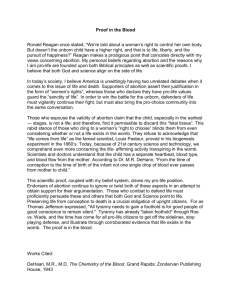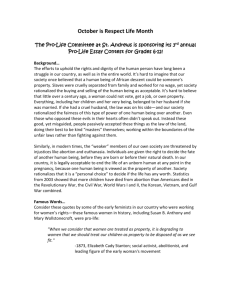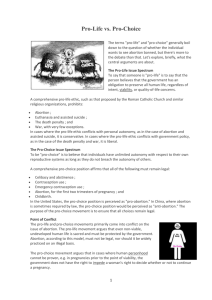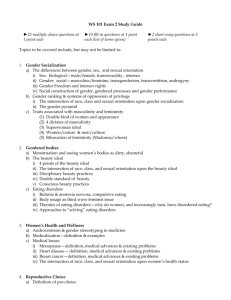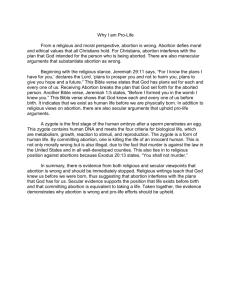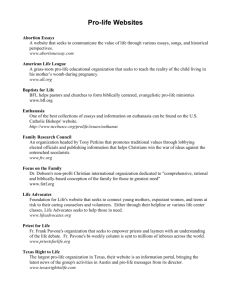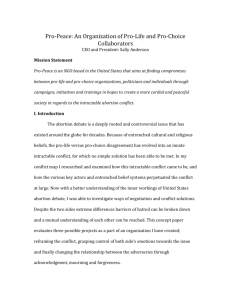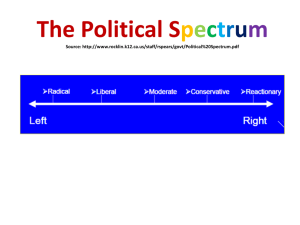Turnaround on Abortion
advertisement
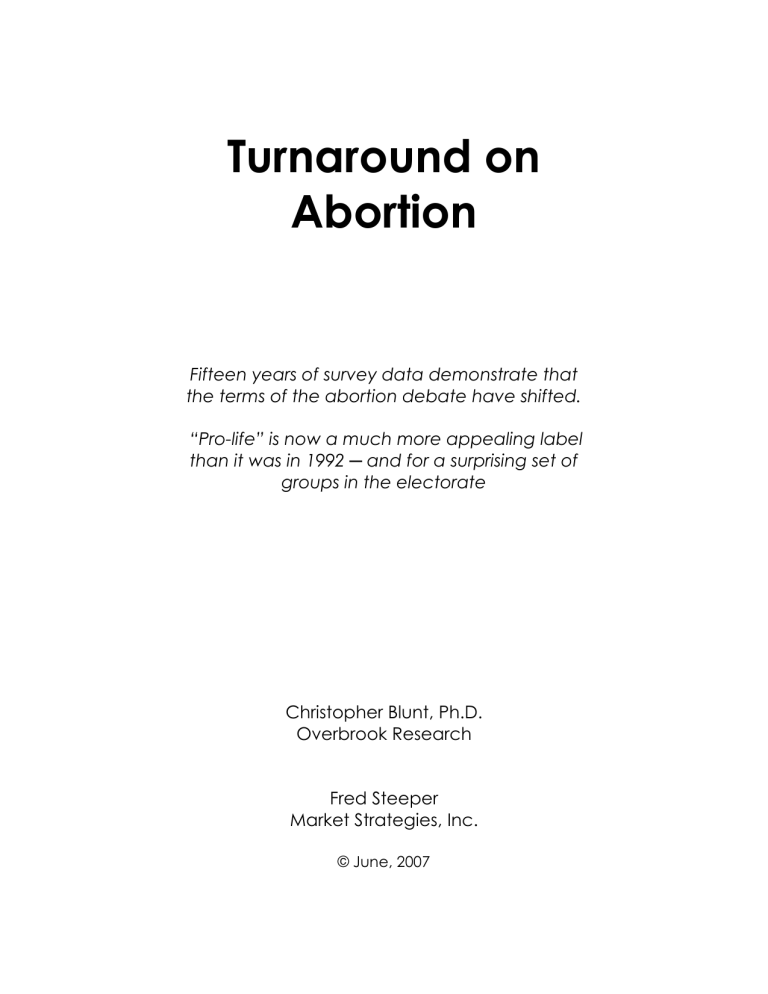
Turnaround on Abortion Fifteen years of survey data demonstrate that the terms of the abortion debate have shifted. “Pro-life” is now a much more appealing label than it was in 1992 ─ and for a surprising set of groups in the electorate Christopher Blunt, Ph.D. Overbrook Research Fred Steeper Market Strategies, Inc. © June, 2007 TURNAROUND ON ABORTION Over the last fifteen or so years, the climate surrounding the abortion issue has changed dramatically. Violence against abortion clinics has become rare, while lateterm “partial-birth” abortion has become the focus of debate, thanks to federal and state legislation and court cases addressing that legislation. The question is, what effect has that climate change had on public attitudes toward abortion? First, remember the abortion wars? In the 1980s and early 1990s, there were dozens of attacks against abortion clinics and the physicians who perform abortions. According to one official government count, between 1977 and 1993, there were at least 36 bombings, 81 arsons, 131 death threats, 84 assaults, 327 clinic invasions, 71 chemical attacks, and over 6,000 blockades of clinic entrances. 1 In response, in 1994, President Clinton signed into law the Freedom of Access to Clinic Entrances (FACE) Act. According to the Democratic-controlled Congress, the law was intended to curtail “[a] nationwide campaign of anti-abortion blockades” and violence that was “barring access to facilities that provide abortion services.” The law worked. Threatened by stiff new federal penalties, Operation Rescue and other vocal anti-abortion groups abruptly ceased their clinic blockades. Dramatic demonstrations and arrests gave way to peaceful prayer vigils and sidewalk counseling. When abortion returned to the headlines less than two years later, the context was entirely different: a Republican-led effort to ban partial-birth abortion. Over the course of several months, details of this gruesome procedure became widely debated. Although polls showed large majorities supporting the ban, pro-choice advocates and their Congressional allies rose to defend the procedure. When the bill reached President Clinton’s desk in early 1996, he vetoed it. Congress was unable to override the veto, but passed a similar ban in 1997, this time with public support from the American Medical Association. Clinton again vetoed the bill, and an override attempt fell just three votes short in the Senate. President Bush eventually 1 signed the ban into law in 2003, and ensuing court cases have kept this issue at the center of the abortion debate. A new set of public opinion data from Missouri offers some important insights as to how the public’s thinking has evolved with this change in climate surrounding the issue. We compiled over 30,000 survey interviews, conducted statewide on behalf of a variety of Missouri campaigns between 1992 and 2006. All respondents were asked: “On the debate over abortion policy, do you consider yourself to be prolife, pro-choice, or somewhere in between?”2 Those taking a side were then asked if they consider themselves strongly pro-life/pro-choice or just somewhat pro-life/prochoice. Although this question is not a reading of what voters believe abortion laws should be (e.g. many “pro-life” voters might think abortion should be legal under certain circumstances), it does serve as a good general gauge of public perceptions of the abortion debate—and, more importantly, how the public aligns itself with the two sides of that debate3. In 1992, at the height of the “abortion wars,” fewer than one-third (30%) of Missouri voters called themselves pro-life, with just 26% admitting to be strongly pro-life. By contrast, 43% called themselves pro-choice, with 34% describing themselves as strongly pro-choice. In other words, there were more strong prochoice advocates than total pro-lifers. By January of 1997, however, with partial-birth abortion the focus of public attention, the two camps reached a rough parity: 36% now called themselves prolife (32% strongly pro-life), with 34% now pro-choice. Just over one-fourth (26%) now described themselves as “strongly” pro-choice. These trends continued through the 1998 and 2000 election cycles, with strong pro-lifers growing to outnumber strong pro-choicers by a 36% to 23% margin. This spread has remained steady through the 2004 and 2006 election cycles. 2 Trend to Missouri Abortion Self-Identification Strongly Pro-Life Somewhat Pro-Life Somewhat Pro-Choice Strongly Pro-Choice In Between 45% 40% 36% 35% 34% 30% 32% 27% 26% 26% 25% 25% 36% 27% 26% 23% 20% 23% 15% 10% 9% 9% 8% 7% 5% 4% 4% 1992 1997 5% 5% 1998-2000 2004-2006 0% It appears that the enactment of the FACE Act, combined with the ascendancy of partial-birth abortion, had a significant impact on public perceptions of the abortion debate—and on perceptions of which side more clearly represents voters’ own values. As grisly details of partial-birth abortion procedures replaced confrontational (and often violent) clinic protests on the evening news, voters seemed to have changed their minds about who the “abortion extremists” were. Recent data from Gallup4 indicate a similar pattern of change at the national level. In the mid-1990s, the pro-choice label enjoyed a 56% to 33% advantage over the pro-life label. The two labels reached a rough parity in 1998, and today the prochoice label’s advantage is only four percentage points (49% to 45%). This is a net swing of 19 points in the pro-life direction; the net pro-life swing of 24 points in Missouri was only slightly larger (from a 13 point pro-choice advantage to an 11 point pro-life advantage). 3 Who Changed? The process of attitude change was not the same for all groups within the Missouri electorate; some underwent considerably more change than others. With 3,350 interviews in 1992 and 11,405 interviews in 2005-2006, it is possible to conduct an extensive subgroup analysis5. The subgroup patterns are consistent with the hypothesis that the change in general climate shifted people’s perceptions of which side of the abortion debate is more extreme. Religiosity Church attendance was and remains the demographic trait most strongly associated with abortion self-identification. Importantly, however, while people at all levels of religiosity grew less strongly pro-choice and more strongly pro-life, the most dramatic movement Shift in Abortion Attitudes by Religiosity came among “secular” voters. In 1992, a majority Strongly pro-life Smwt pro-choice continued to be pro-choice in 2005-2006, the proportion calling itself Weekly or More pro-life. While this group Almost Weekly in ten had been strongly 2006 Monthly strongly pro-choice; just one 2006 2006 Seldom church (53%) had been 2006 19% 1992 11% 3% Never of those never attending 2006 20% 1992 10% 3% strongly pro-life had doubled, and the percent strongly pro-choice had Smwt pro-life Strongly pro-choice 59% 1992 5% 51% 4% 39% 1992 7% 30% 6% 26% 1992 14% 5% 23% 37% 28% 17% 7% 9% 23% 9% 23% 39% 9% 34% 15% 6% 31% 34% 4% 11% 22% 32% 6% 5% Middle/No opinion 32% 10% 47% 11% plummeted to 35%. Similarly, among those seldom attending church, the percent strongly pro- 0% 4 3% 25% 20% 33% 53% 9% 40% 35% 9% 60% 80% 100% choice dropped from 47% to just 32%. By contrast, weekly churchgoers had been majority strongly pro-life in 1992 (51%), and the passing of time added only slightly to that majority (59%). In other words, the electorate’s attitudinal shift was not due to sympathetic groups’ expanding their pro-life majorities, nor does it seem driven by messages preached in church. Instead, it appears that secular voters grew disillusioned with the “pro-choice” label and abandoned it in droves. Religion This is not to say that religion had nothing to do with the shifts that occurred over time. The pro-life movement had been largely Catholic in its early years, but over time expanded into evangelical Protestant congregations. This expansion seems to have had an impact on the electorate. Catholics remained virtually unchanged on the abortion issue between 1992 (37% strongly pro-life / 24% strongly pro-choice) and 2005-2006 (39% / 20%). Protestants, by contrast, reversed themselves. They had been 24% strongly pro-life and 35% strongly pro-choice in 1992; by 2005-2006 they were almost identical to Catholics (37% / 22%). Change in Abortion Identification by Religion Other/None Protestant Catholic Strongly pro-life 2006 Smwt pro-life 39% Middle/No opinion 6% 1992 37% 5% 2006 37% 5% 1992 24% 2006 23% 1992 11% 0% 4% 4% 10% 30% 24% 7% 9% 22% 35% 8% 9% 31% 53% 50% 5 20% 8% 29% 40% Strongly pro-choice 7% 26% 36% 23% 20% 28% 28% 3% Smwt pro-choice 60% 70% 80% 90% 100% Education Education is also associated with abortion attitudes, with pro-choice support tending to increase with years of schooling. That relationship seems to have weakened considerably since 1992, however. Fifteen years ago, those with postgraduate degrees were overwhelmingly strongly pro-choice (42%); fewer than one in five (18%) would admit to being strongly pro-life. Those with at least some undergraduate education (or an undergraduate degree) also had a sizable pro-choice plurality; only among those with no college education did the strongly pro-life label even approach parity with the strongly pro-choice label. Currently, however, education has no impact on a person’s propensity to self-identify as strongly pro-life. Among post-graduates, the proportion strongly pro-life nearly doubled (from 18% to 35%), while the strongly pro-choice proportion dropped from 42% to 28%. Given that attention to the news and current affairs tends to increase with years of education, these more dramatic shifts among post-graduates may reflect their greater exposure to news about the abortion issue. When the news was dominated by clinic blockades, post-graduates were the most strongly pro-choice. As that news environment has changed, Change in Abortion Identification by Education it is not graduate perceptions have changed the most. Any Undergrad that post- PostGraduate surprising No College Strongly pro-life 2006 Smwt pro-life Middle/No opinion 1992 2006 1992 2006 5% 35% 1992 18% 0% 10% 20% 30% 6 40% 50% 28% 8% 23% 42% 11% 25% 4% 37% 9% 23% 5% 26% 26% 8% 27% 5% 35% 18% 30% 8% 31% 4% 27% Strongly pro-choice 6% 35% 5% 36% Smwt pro-choice 60% 70% 80% 90% 100% Gender Other studies have noted that the net differences between men and women on the abortion issue tend to be small, but that women tend to be more polarized in their views. Women hold stronger opinions on both sides of the abortion debate for two general reasons: on the one hand, because only women directly need “the choice” of abortion services—but, on the other hand, because women who carry babies to term have a more powerful and personal experience of the unborn child’s humanity than a man could have. We found this general pattern of opinion to be true in both 1992 and 2005-2006. In 1992, women were more likely than men to take a strongly pro-life stance (28% for women versus 23% for men) or a strongly pro-choice stance (35% versus 32%), with little net difference between the two genders. That was also the case in 20052006, with women taking stronger positions than men on both the pro-life side (37% versus 34%) and the pro-choice side (25% versus 20%), with almost no net difference by gender. Change in Abortion Identification by Gender Strongly pro-life 2006 Smwt pro-life Middle/No opinion Strongly pro-choice 20% 8% 33% 6% Men 34% Smwt pro-choice 1992 2006 25% 7% 28% 4% Women 37% 32% 10% 30% 5% 23% 1992 3% 28% 0% 10% 20% 30% 40% 50% 7 35% 8% 25% 60% 70% 80% 90% 100% Age Some have speculated that there is a self-interest component to abortion attitudes, and that the young—particularly young women—ought to be more supportive of legal abortion than those whose childbearing years have passed. That seems to have been true in 1992: those under age 30 (both women and men) were the most strongly pro-choice (39%), and the least strongly pro-life (23%). Those aged 30-49 were just slightly less pro-choice (36% strongly pro-choice / 25% strongly prolife); only those aged 50 and older were evenly divided on the issue (30% strongly pro-choice, 29% strongly pro-life). Moreover, within each of these age groups, women were more strongly pro-choice than men were. While this might be evidence for the self-interest hypothesis, something interesting happened to the newest voters entering the electorate. Today’s 18-29 year olds are as strongly pro-life (36%) as older voters, and are less strongly prochoice (18%) than their elders. This youngest cohort’s passage into adulthood coincided with the ascendance of partial-birth abortion as the issue’s dominant frame; for them, the “abortion wars” of the 1980s and early 1990s were a dim memory at best. This is also the generation for whom fetal ultrasound images (often of a very high quality) have become ubiquitous, which has doubtlessly increased the sensitivity of many to the possible humanity of the unborn child. Furthermore, these voters have come of age with legal abortion, perhaps with the realization that they themselves could have been aborted had their parents “chosen” differently. As a result, today’s young voters have had their perceptions of the abortion issue shaped by many considerations other than a self-interested desire to divorce sex from its consequences. Indeed, particularly for those who may have reflected on the narrowness with which they themselves might have escaped abortion, the whole notion of self-interest seems to have been stood on its head. The group generally thought of as having the largest self-interest stake in abortion, women under age 30, made a particularly dramatic turnaround. In 1992, as the self-interest hypothesis would predict, young women had been more strongly pro-choice than pro-life by a nearly two-to-one margin (42% strongly pro-choice / 8 24% strongly pro-life). Furthermore, they were more strongly pro-choice than any other group of women or men—and among the least strongly pro-life. However, today’s young women are now the most strongly pro-life (40%) and least strongly pro-choice (20%) group, reversing the two-to-one ratio of 1992. (Young men have followed suit in their pattern of change, but with their intensity remaining lower on both sides.) Women 18-29 Women 30-49 2006 2006 Men 30-49 Men 18-29 2006 Women 50+ Shift in Abortion Attitudes by Age and Gender Strongly pro-life Smwt pro-life Smwt pro-choice Strongly pro-choice 40% 1992 24% 4% 4% 1992 5% 36% 32% 2006 33% 1992 4% 1992 23% 2006 28% 4% 34% 25% 6% 31% 8% 37% 36% 31% 28% 5% 16% 8% 11% 6% 34% 2006 38% 7% 27% 6% 26% 7% 29% 2% 4% 22% 42% 25% 24% 20% 6% 9% 4% 27% 1992 30% 21% 38% Middle/No opinion 21% 9% 34% 11% 21% 7% Men 50+ 33% 25% 1992 0% 6% 20% 32% 40% 9 9% 60% 29% 80% 100% Partisan Coalitions These changes in attitudes about the abortion issue, as other scholars have noted, have had an important impact on the composition of the two parties. Those on both sides of the issue are more likely now than in 1992 to identify with the political party which represents their own beliefs about abortion—and, not surprisingly, this partisan realignment has been Shift in Party Identification by Abortion Position more pronounced among Republican dropped to one-fourth today. Likewise, 30% of strongly pro-choice voters were Republicans in 1992; today, only 21% are. Voters who are only somewhat pro-choice moved toward the Democrats by a lesser margin, and those who are only somewhat pro-life Strongly Pro-Life Democrats; this has 2006 53% 1992 54% Middle/ No opinion pro-life voters were Somewhat Pro-Choice 1992, one-third of strongly Strongly Pro-Choice positions on abortion. In 2006 Somewhat Pro-Life those with stronger Independent Democrat 62% 1992 12% 58% 2006 32% 1992 9% 13% 1992 30% 0% 20% 49% 45% 13% 58% 51% 14% 11% 21% 34% 15% 35% 2006 34% 18% 29% 1992 33% 14% 40% 2006 25% 68% 12% 40% 58% 60% 80% 100% hardly moved at all. However, because the electorate as a whole has become more pro-life and less pro-choice, these numbers tell only part of the story. The increasing number of prolife voters has led to a dramatic change on the composition of the Republican party coalition. In 1992, the Missouri Republican party was divided on the abortion issue: 36% were strongly pro-life, but nearly one-fourth were strongly pro-choice. By 10 contrast, the Democratic party was much more strongly pro-choice (42%) than strongly pro-life (18%). The 2006 electorate is considerably different: the Republican party is now overwhelmingly pro-life, while Democrats (though still plurality prochoice) are more divided than they were—and much more divided than Republicans now are. This may help explain why some Democratic candidates have tended to downplay abortion in recent years, while Republicans have felt confident to take the offensive on issues such as waiting periods and parental consent. Changes in Party Composition by Abortion Attitudes Republican Coalition Democratic Coalition 1992 2006 Change 1992 2006 Change Strongly Pro-Life 36.2 53.8 +17.7 18.3 19.8 +1.5 Somewhat Pro-Life 5.2 6.2 +1.0 2.9 3.7 +.8 Middle/No opinion 26.7 23.4 -3.3 26.6 32.8 +6.2 Somewhat Pro-Choice 7.5 5.0 -2.5 9.7 9.2 -.5 Strongly Pro-Choice 24.4 11.6 -12.8 42.5 34.6 -7.9 Conclusions The political landscape with regard to the abortion issue has changed significantly in the last fifteen years. No longer must pro-life leaders explain the presence of clinic bombers and other extremists within their movement; instead, it is the pro-choice movement which must explain its support for partial-birth abortion and opposition to popular policies such as parental consent. Not only has the public been paying attention, but average voters have been drawing their own conclusions about who the abortion extremists are—and changing sides to reflect those conclusions. Ironically, the Freedom of Access to Clinic Entrances Act which pro-lifers so strongly opposed in 1994 seems to have yielded profound benefits for the pro-life movement. The labels “Republican” and “Democrat” can hold meaning for the electorate, and change in their relative valence over time, even as net support for each party’s policy platform may remain constant. The labels themselves serve as an information shortcut for voters as to who the “good guys” and “bad guys” are. The 11 “pro-life” and “pro-choice” labels can serve a similar function. Given how the public’s self-identification on abortion has changed, the pro-life label is no longer a disadvantage for candidates seeking public office. In fact, it now carries a net positive valence in Missouri—and probably in many other states as well. This is not to say that voters have become any more or less supportive of specific abortion restrictions; such a conclusion is beyond our data. What we can say with confidence is that there has been a dramatic change in the climate surrounding the abortion issue—and that pro-life candidates should feel more confident in identifying themselves as such. Christopher Blunt operates Overbrook Research, a public opinion consulting practice, in Illinois. He has been designing, conducting, and analyzing quantitative and qualitative research since 1991. His analysis has helped shape Republican campaign strategies nationally and in many individual states, including Missouri. In the most recent election cycle, his analysis played an integral role in the RNC’s microtargeting efforts in dozens of campaigns. Dr. Blunt was a study director and analyst with Market Strategies, Inc. for a dozen years, before founding Overbrook Research in 2003. He holds a Ph.D. in political science from UCLA. Fred Steeper is a consultant at Market Strategies Inc. and one of its founders. A nationally recognized expert in political behavior and electoral research, Mr. Steeper has designed polling, focus group and ad testing research in more than 100 U.S. Senate and gubernatorial campaigns since 1972 with a 70%-plus winning record. Mr. Steeper has had significant public opinion research roles in nine GOP presidential races spanning more than 30 years. He was one of two principal polling and focus group consultants to the George W. Bush 2000 presidential campaign and conducted special research projects for the 2004 campaign. In addition, Mr. Steeper was the senior polling consultant for the George Bush 1988 and 1992 presidential campaigns. He directed the polling programs for President Nixon in 1972 and President Ford in 1976. For the 1980 and 1984 Reagan campaigns, he directed the strategic and tracking research in the key Midwestern states. http://www.usdoj.gov/usao/eousa/foia_reading_room/usam/title8/cvr00006.htm The “pro-life” and “pro-choice” labels were rotated when the surveys were administered, meaning half heard “pro-life” first and half heard “pro-choice” first. 3 Indeed, many national surveys such as Gallup, the General Social Survey, and the National Election Study, have not shown dramatic changes in support or opposition to abortion under particular circumstances. 4 http://www.galluppoll.com/content/default.aspx?ci=27628 5 Subgroup sizes are generally quite large. The smallest is n=246 for young women in 1992; the next smallest is n=306 for post graduates in 1992. All the 2005-2006 subgroups are at least n=774, and most number in the thousands. 1 2 12 FOR MORE INFORMATION, CONTACT: Christopher Blunt Overbrook Research 855 North 1800E Rd. Loda, IL 60948-9422 217-390-8006 CCBlunt@OverbrookResearch.com
